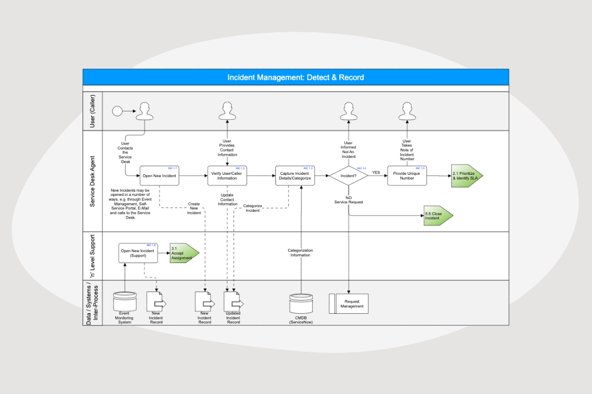Incident Management Best Practices
We're pleased to provide this comprehensive guide to Incident Management Process best practices. Whether you want to enhance your existing process or create a new one, this guide has you covered!
Navvia is excited to present the first in the series of in-depth process guides intended to provide best practices for the five foundational ITSM processes every organization needs to have in place.
For each process, we provide a process description, key benefits, roles, responsibilities, a description of the significant activities, tips on process governance, and some design and implementation guidance.
Incident Management Description
Incident management is a crucial process that organizations must have in place to effectively respond to and resolve any disruptions or incidents that may occur.
Incident management involves a series of steps and procedures aimed at minimizing the impact of incidents, restoring normal operations as quickly as possible, and providing the information needed through integration with problem management to prevent future incidents from happening.
Incident Management includes all the activities and tasks required to:
- Detect and record incidents
- Prioritize incidents and provide initial support
- Investigating and diagnosing incidents
- Resolving and recovering from incidents
- Closing the incident
Incident Management is an ongoing process that requires continuous monitoring and improvement, ensuring it remains beneficial to the organization.
By following best practices and having a well-defined Incident Management process, organizations can minimize the impact of incidents and maintain a high degree of customer satisfaction with their IT services.
Incident Management Benefits
The Incident Management process offers numerous benefits for businesses.
- One of the key advantages is the ability to minimize the impact of incidents on the organization. By promptly detecting and recording incidents, organizations can take immediate action to mitigate any disruptions and prevent them from escalating further.
- Additionally, the process allows for the prioritization of incidents, ensuring that the most critical issues are addressed first and given the necessary initial support.
- Through thorough investigation and diagnosis of incidents, organizations can support problem management, identify root causes, and implement effective solutions to prevent future occurrences.
- Furthermore, the process facilitates swift resolution and recovery from incidents, enabling businesses to resume normal operations as quickly as possible.
- Finally, through continuous monitoring and improvement of the Incident Management process, organizations can enhance their preparedness and resilience, ensuring they are well-equipped to handle any incident.
Incident Management and Cyber Security
A robust Incident Management process is essential for effective cybersecurity, particularly in security incident response.
Organizations can quickly identify and address security breaches by implementing a structured incident response framework alongside Security Event and Incident Management (SEIM) tools, minimizing their impact and reducing downtime.
This proactive approach enables cybersecurity teams to swiftly contain threats, mitigate damage, and restore normal operations, safeguarding critical assets and sensitive data.
Additionally, thorough documentation and analysis of each incident empower organizations to learn from security events, uncover underlying vulnerabilities, and strengthen their defenses against future cyber attacks.
Investing in an effective Incident Management process is crucial for enhancing overall cybersecurity resilience and protecting organizational integrity.
Read our post on Boosting Cyber Resilience with IT Security Assessments and ITSM Processes and Building an IT Security Management Process for more information on improving your cyber security posture.
Incident Management Roles and Responsibilities
Here is a summary of the typical Incident Management process roles. It is important to note that these roles do not indicate any hierarchical status within the organization, and their responsibilities are limited to that particular process.
Having clearly defined roles and responsibilities is crucial for the efficient execution of any process. This clarity helps ensure that everyone is on the same page and clearly understands their place in the process.
Here are some typical roles for the Incident Management process.
Incident Management Process Owner
A Senior Manager responsible for ensuring that all departments within the IT organization implement and use the process effectively.
Their specific tasks include:
- Defining the process's mission.
- Communicating process goals and objectives to all stakeholders.
- Resolving any cross-functional issues.
- Ensuring consistent execution across departments.
- Reporting on process effectiveness to senior management.
- Initiating process improvements as necessary.
Incident Management Process Manager
The Process Manager is in charge of overseeing the daily implementation of the process. They receive guidance from the Process Owner to ensure that the process is executed uniformly throughout the organization.
Their duties include:
- Managing the process's daily tasks.
- Collecting and presenting process metrics.
- Monitoring compliance with the process.
- Reporting any process-related issues.
- Chairing process meetings.
They may also manage major incidents (see major incident manager below).
Service Desk Manager
The role of a service desk manager involves:
- Managing the daily operations of the service desk.
- Leading the service desk team.
- Representing the team to other departments.
They ensure that the IT service desk adheres to industry best practices and standards. Additionally, they are responsible for monitoring and evaluating the performance of the service desk staff, providing constructive feedback and coaching, and managing to ensure adherence to defined metrics and benchmarks.
The service desk manager also plays a crucial role in recruiting, training, and supporting the help desk team and resolving technical issues and concerns efficiently.
Service Desk Agent
The service desk is responsible for managing the lifecycle of incidents from registration to closure.
The service desk agent oversees incident registration, monitoring, tracking, and communication. Additionally, they conduct incident investigations and diagnoses and provide resolutions and workarounds based on Standard Operating Procedures and existing Problems and Known Errors.
If a resolution or workaround cannot be found, incidents are escalated to Incident Support groups. Finally, the service desk agent is responsible for closing incidents.
Finally, the service desk agent is responsible for closing incidents.
Incident Coordinator
As the "point person" of a support group, this role holds full accountability for all Incidents assigned to the group.
The incident coordinator is responsible for monitoring the respective queues for assigning Incidents and reassigning them to the appropriate individuals for further investigation. Additionally, the incident coordinator plays a vital role in escalating Incidents to other groups.
This role is often called the queue manager.
"N' Level Support Groups
The support groups have several responsibilities, including investigating and diagnosing escalated incidents from the Service Desk.
They also develop workarounds, identify and create problem records, resolve and recover assigned incidents, and create new incidents if they detect a service failure, quality degradation, or a situation that may lead to one.
User / Caller
A user or caller is responsible for informing the Service Desk about any incidents and providing them with detailed information as requested.
The user/caller also participates in implementing a solution or workaround and verifies its correct operation.
Incident Management Activities

Here at Navvia, we strongly believe in simplifying complex processes by breaking them into high-level activities.
These activities serve as a guide, outlining the crucial steps in the process and the connections between them. We then map out the detailed tasks required to complete each activity. Organizing processes in this way makes understanding and communicating the process easier.
The following are the critical activities of the Incident Management Process.
Detect and record incidents
The Detect & Record activity involves identifying Incidents through human observation or system monitoring. It is crucial to gather all relevant information about the Incident at its creation. During this process, we determine the category of the issue and its symptoms. If the case is a Service Request, they redirect it to the Request Fulfillment process.
Prioritize incidents and provide initial support
During this activity, we associate the incident with the relevant service level agreement and determine values for impact, urgency, and priority parameters. We may declare a major incident and follow the appropriate procedures if necessary. We also conduct incident matching to identify duplicate incidents and find a solution or workaround. We notify relevant stakeholders based on priority parameters.
Investigating and diagnosing incidents
During this activity, workarounds are either located or developed. It's possible that other support groups may need to be contacted for assistance. If the Incident cannot be linked to an existing problem, a new one is created.
Resolving and recovering from incidents
In this activity, we will implement the solution or workaround identified or created in the previous step. If necessary, a CR (change request) will be submitted and the Change Management process will oversee the implementation. In addition, recovery actions may also be taken based on the severity of the Incident.
Closing the incident
After successfully implementing a workaround or solution, it is essential to close the Incident. The service desk reaches out to the affected user(s) to confirm their acceptance of the resolution and to gather any further feedback on how the issue was handled. The service desk documents the details of the solution and select an appropriate closure and cause code.
Incident Management Process Governance
Process governance is an essential aspect of the Incident Management process. It involves establishing a framework to ensure an organization effectively manages and executes the process.
The Incident Management process owner plays a critical role in process governance, defining the process's mission and communicating its goals and objectives to all stakeholders. They also resolve cross-functional issues and initiate improvements to enhance the process's effectiveness.
The process manager oversees the daily implementation of the process, ensuring uniform execution throughout the organization. They collect and present process metrics, monitor compliance and report process-related issues.
Additionally, the service desk manager plays a crucial role in process governance by managing the daily operations of the service desk and ensuring adherence to industry best practices.
Working as a team, the process owner, process manager, and other stakeholders should periodically assess the process looking for gaps and potential areas of improvement. One way to do this is through a formal process assessment. Learm more about assessments by reading The Importance of a Process Maturity Assessment.
Through process governance, organizations can maintain consistency, efficiency, and continuous improvement in their Incident Management practices.
Incident Management Process Design and Implementation
Believe it or not, implementing an ITSM process is more complex than just installing an ITSM tool. It requires a well-defined process to ensure a successful implementation. To help organizations navigate this process, we recommend following these five steps:
- Identify gaps in your current process and supporting tools: Before implementing a new process, it's important to assess your existing process and tools to identify any areas that may need improvement. This review should include outdated documentation, gaps in ITSM tool functionality, or lack of integration between different systems.
- Collaborate with stakeholders to understand their process requirements: Involving all relevant stakeholders in the implementation process is crucial. These stakeholders include not only the information technology team but also all business stakeholders. By engaging with stakeholders early on, you can gather their input and ensure that their requirements are included in the design and implementation of the incident management process.
- Define and document your incident management process: Once you have identified the gaps and gathered input from stakeholders, it's time to define and document your incident management process. This task involves clearly defining the steps and activities involved in managing incidents, as well as establishing roles and responsibilities. It's important to align the process with industry best practices, such as ITIL (Information Technology Infrastructure Library), COBIT, or ISO20000 to ensure consistency and efficiency.
- Capture user stories and requirements to guide the developer or implementer: To effectively implement the Incident Management process in the ITSM tool, capturing user stories and requirements is crucial. This activity involves understanding end-users specific needs and expectations and translating them into actionable tasks for the developer or implementer, ensuring the tool meets user needs.
- Ensure sustainability by providing ITSM training, defining controls, reporting metrics, and implementing governance: To ensure long-term success, provide Incident Management training to users and Information Technology organization staff. In addition, define controls for process governance, track performance with metrics, and implement continuous monitoring and improvement.
By following these five steps, organizations can ensure a successful implementation of the Incident Management Process and supporting ITSM tools.
Additional Resources
Here are links to additional resources to
- Webinar: Leading a Successful ITSM Tool Implementation
- Webinar: Best Practices in Process Design and Documentation
- Blog: An Introduction to Process Mapping
- Blog: Process Documentation: A Complete Guide
- Blog: Building the Business Case for ITSM Brest Practices
Organizations must have a robust Incident Management process to efficiently and effectively address and resolve incidents. By adhering to industry best practices and constantly enhancing the process, companies can reduce the negative impact of incidents, keep customers satisfied, and maintain seamless operations.


